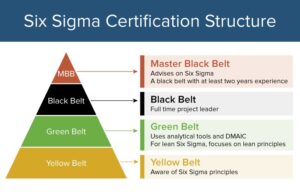In today’s competitive landscape, businesses seek methodologies to streamline processes and drive continuous improvement.
Lean Six Sigma courses offer a comprehensive approach, integrating Lean principles for waste reduction with Six Sigma’s data-driven analysis for quality enhancement.
These courses empower professionals to identify inefficiencies, minimize defects, and optimize operations.
By mastering Lean Six Sigma principles, individuals gain valuable skills to enhance productivity, reduce costs, and deliver superior products and services.
Investing in Lean Six Sigma training not only equips employees with essential tools but also cultivates a culture of efficiency and excellence, essential for sustainable success in the modern business environment.
Lean Six Sigma methodology emerges as a beacon of excellence in achieving these goals. However, navigating through the various levels of Lean Six Sigma certification can be daunting.
Fear not, for we are here to decode the intricacies of Lean Six Sigma courses in plain language.
Understanding Lean Six Sigma Courses:
Lean Six Sigma is a powerful blend of two methodologies—Lean principles and Six Sigma techniques—aimed at process improvement and waste reduction.
These methodologies offer a structured approach to problem-solving, ensuring organizations deliver high-quality products or services consistently.

Lean Six Sigma White Belt:
The Lean Six Sigma White Belt certification serves as an introduction to the fundamentals of Lean Six Sigma.
It equips individuals with a basic understanding of the methodologies, concepts, and terminologies involved.
White Belt holders often contribute to improvement projects within their respective areas, supporting the implementation of Lean Six Sigma practices.
Lean Six Sigma Yellow Belt:
Moving up the ladder, the Yellow Belt certification dives deeper into Lean Six Sigma methodologies. Yellow Belt holders acquire a comprehensive understanding of process improvement tools and techniques.
They actively participate in improvement initiatives under the guidance of Green and Black Belt professionals, driving incremental enhancements within their domains.
Lean Six Sigma Green Belt:
Green Belt certification signifies a deeper commitment to process improvement and project management.
Green Belts possess a thorough understanding of DMAIC (Define, Measure, Analyze, Improve, Control) methodology and are proficient in utilizing statistical tools for data analysis.
They lead smaller-scale improvement projects independently, delivering measurable business results.
Lean Six Sigma Black Belt:
Black Belt certification represents mastery of Lean Six Sigma principles and methodologies.
Black Belts are adept problem-solvers, capable of leading complex improvement projects from inception to completion.

They mentor Green Belts and Yellow Belts, facilitate organizational change, and drive significant improvements in quality, cost, and delivery.
Lean Six Sigma Master Black Belt:
At the zenith of Lean Six Sigma expertise lies the Master Black Belt certification.
Master Black Belts are strategic leaders who play a pivotal role in shaping organizational performance. They possess advanced knowledge of statistical analysis, change management, and leadership.

Master Black Belts spearhead large-scale transformation initiatives, aligning business strategies with operational excellence.
Conclusion
Lean Six Sigma courses offer a structured pathway for individuals and organizations to achieve operational excellence.
Whether you’re embarking on your Lean Six Sigma journey or aiming for mastery, each certification level equips you with valuable skills to drive continuous improvement and deliver tangible business outcomes.
So, embrace the journey, elevate your skills, and become a catalyst for transformation in your organization.





